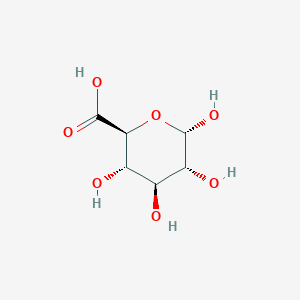| General Information of MET (ID: META00169) |
| Name |
Glucuronic acid
|
| Synonyms |
Click to Show/Hide Synonyms of This Metabolite
D-(+)-Glucuronate; D-(+)-Glucuronic acid; D-Glucopyranuronic acid; D-Glucuronate; GCU; GlcAa; GlcAalpha; Glucosiduronate; Glucosiduronic acid; Glucuronate; Glucuronic acid; alpha-D-Glucopyranuronic acid; alpha-D-Glucuronic acid
|
| Source |
Endogenous;Drug Metabolite;Drug;Escherichia Coli Metabolite;Food;Plant Metabolite; Microbial
|
| Structure Type |
Carbohydrates and carbohydrate conjugates (Click to Show/Hide the Complete Structure Type Hierarchy)
Organic oxygen compounds
Organooxygen compounds
Carbohydrates and carbohydrate conjugates
|
| PubChem CID |
|
| HMDB ID |
|
| Formula |
C6H10O7
|
| Structure |
<iframe style="width: 300px; height: 300px;" frameborder="0" src="https://embed.molview.org/v1/?mode=balls&cid=444791"></iframe>
|
 |
|
3D MOL
|
2D MOL
|
|
Click to Show/Hide the Molecular/Functional Data (External Links/Property/Function) of This Metabolite
|
| KEGG ID |
|
| ChEBI ID |
|
| FooDB ID |
|
| ChemSpider ID |
|
| METLIN ID |
|
| Physicochemical Properties |
Molecular Weight |
194.14 |
Topological Polar Surface Area |
127 |
| XlogP |
-2.3 |
Complexity |
205 |
| Heavy Atom Count |
13 |
Rotatable Bond Count |
1 |
| Hydrogen Bond Donor Count |
5 |
Hydrogen Bond Acceptor Count |
7 |
| Function |
Glucuronic acid (CAS: 6556-12-3) is a carboxylic acid that has the structure of a glucose molecule that has had its sixth carbon atom (of six total) oxidized. The salts of glucuronic acid are known as glucuronates. Glucuronic acid is highly soluble in water. In humans, glucuronic acid is often linked to toxic or poisonous substances to allow for subsequent elimination, and to hormones to allow for easier transport. These linkages involve O-glycosidic bonds. The process is known as glucuronidation, and the resulting substances are known as glucuronides (or glucuronosides). Glucuronidation uses UDP-glucuronic acid (glucuronic acid linked via a glycosidic bond to uridine diphosphate) as an intermediate. UDP-glucuronic acid is formed in the liver of all animals.
|
|
Regulatory Network
|
|
|
|
|
|
|
|
|
 click to show the details of this protein
click to show the details of this protein
 click to show the details of experiment for validating this pair
click to show the details of experiment for validating this pair

